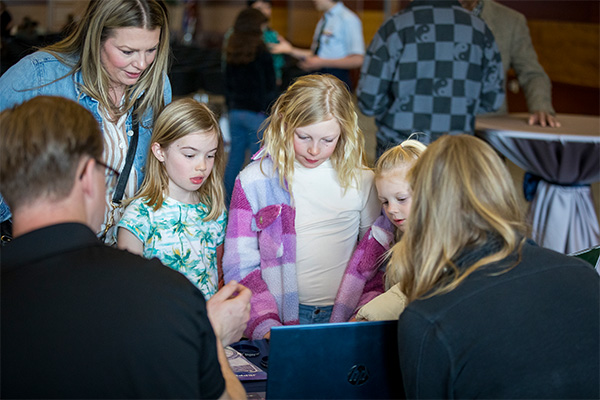In space, dessert is less appealing than it is on Earth.
“You don’t really want sweet things,” retired NASA astronaut and U.S. Air Force Col. Eileen Collins told the crowd of about 300 people — many of them teens and younger — at the Women in Space event March 21 on the University of Nevada, Reno campus.
Collins answered questions from the crowd — including a question about astronaut ice cream — after discussing her path to NASA and sharing stories about life on the International Space Station.

Also at the event: Molly Hull, a teacher at Marce Herz Middle School, received the $2,500 Excellence in Aviation and STEM Education Award from the Gillemot Foundation; and Tom Hall, one of the Gillemot Foundation trustees, received the “propeller award” — an airplane propeller signed by pilots from the Reno Air Races. The Gillemot Foundation last fall gifted the University $36 million to expand the aerospace engineering program within the College of Engineering and to create the George W. Gillemot dome in the College of Science’s Fleischmann Planetarium.
The Women in Space event was co-hosted by the University of Nevada; University of Nevada Research & Innovation; the College of Engineering; Washoe County School District; and Pathways to Aviation, a nonprofit supporting the current and future aviation workforce.
‘The real deal’
Former NASA flight director and Northern Nevada resident Paul Dye, a past colleague of Collins, introduced her to the crowd with a story: years ago, both worked on a Discovery mission to rendezvous with the Russian Mir Space Station. She was piloting space shuttle Discovery — the first woman to do so — and he was back in Mission Control as lead flight director. He praised her piloting skills and calm demeanor.
“She’s what we call the real deal,” he said.
But becoming a "real deal" astronaut takes a lot of work. For Collins, that work started in the late 1970s with pilot training at Vance Air Force Base in Oklahoma. One of the first women to go through the training, Collins said she and the three other women in her class succeeded by “being prepared and being serious about what we were doing.”
After that, she worked as an instructor pilot and then taught at the U.S. Air Force Academy, according to her NASA biography. She was selected for the astronaut program in 1990. Over the next 15 years, she would participate in four space flights. She shared anecdotes from those flights, including the story of astronauts Soichi Noguchi and Stephen Robinson, who replaced a broken gyroscope on the Space Station in 2005.
Collins finished her talk by taking questions from the audience, including the one about astronaut ice cream. And no, she has never tried astronaut ice cream — a freeze-dried concoction — but she did once fly into space with real ice cream.
On one mission to the Mir Space Station, she and her crew were tasked (among other things) to transport an empty freezer to collect a scientific experiment that would be returned to Earth. Before launch, it was decided to fill the freezer with about 70 small containers of ice cream, Collins said, “those ones with the little wooden spoons.”
But when they got to Mir, they didn’t feel like eating the ice cream. And when it was time to return to Earth with the freezer — now loaded with the science experiment — they had a problem: what do you do with the ice cream?
“You can’t throw it in the garbage,” she said.
Her commander jokingly ordered them to eat the ice cream. In the end, they looked to their space station hosts for a solution.
“We gave it to the Russians, and they ate it all,” she said.
















